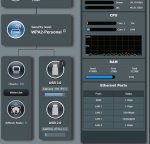Zentachi
Regular Contributor
Currently I have an asus ac86u router with around 60 devices connected.
7 wired / 9 on 5Ghz and the rest on 2.4 Ghz majority being IOT (30+ devices).
I use the latest merlin firmware on my asus, few scripts and openvpn.
I am moving soon and the asus won't be sufficient both in terms of coverage and the amount of clients (more IOT devices will be installed).
New place is around 90sqm (970sqf) split in two floors.
I was thinking of maybe getting another ac86u and connect it by ethernet (CAT6).
However, I am afraid that this might not be the best solution with 70+ clients and devices might get frequent disconnections.
I have read about ruckus that can support 100+ clients and have seen solutions like ubiquity, omada, etc. But I am too confused.
I saw also this post from Trip https://www.snbforums.com/threads/multiple-routers-or-mesh.67798/#post-636991
which seems to maybe fit my situation.
I don't expect a plug and play solution and don't mind getting dirty and learn.
Your recommendations and opinions will be greatly appreciated.
7 wired / 9 on 5Ghz and the rest on 2.4 Ghz majority being IOT (30+ devices).
I use the latest merlin firmware on my asus, few scripts and openvpn.
I am moving soon and the asus won't be sufficient both in terms of coverage and the amount of clients (more IOT devices will be installed).
New place is around 90sqm (970sqf) split in two floors.
I was thinking of maybe getting another ac86u and connect it by ethernet (CAT6).
However, I am afraid that this might not be the best solution with 70+ clients and devices might get frequent disconnections.
I have read about ruckus that can support 100+ clients and have seen solutions like ubiquity, omada, etc. But I am too confused.
I saw also this post from Trip https://www.snbforums.com/threads/multiple-routers-or-mesh.67798/#post-636991
which seems to maybe fit my situation.
I don't expect a plug and play solution and don't mind getting dirty and learn.
Your recommendations and opinions will be greatly appreciated.



